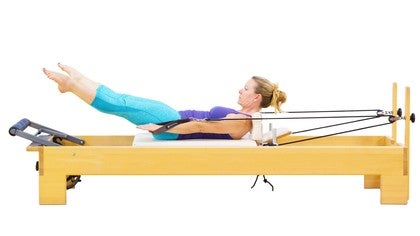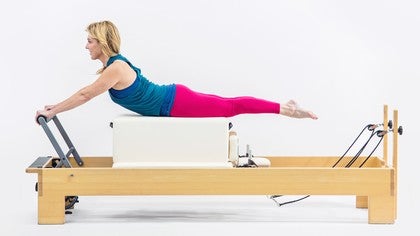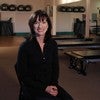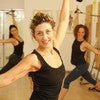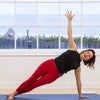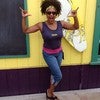Description
Muscle Focus: Abdominals, inner thighs, and the backs of the legs.
Objective: Stabilizing the powerhouse and strengthening the abdominals.
Reformer Setup: Start with two medium tension springs. A heavier spring setting will create more resistance for the legs, while a lighter spring setting will create more work for the abdominals. The footbar is up.
Start Position: Lie on your back, holding the handles in both hands, and placing both feet on the footbar. Press through the feet to extend the carriage out, and place the right foot into the right strap. Place the left foot into the left strap. Press both arms straight and firm into the carriage, bring the legs into frog position (thigh bones perpendicular to the body in a tabletop position, externally rotating the thigh bones and bringing the knees a little wider than hips distance apart, gluing the heels together with toes apart).
Movement:
Frog: Press both legs out to straight, keeping the heels glued together, with the thigh bones wrapping in external rotation, and the pelvis anchored into the carriage. Keeping the spine long and the pelvis stable, bend both knees with the heels together, returning to start position. Repeat three to five more times.
Openings: Press both legs out to straight, keeping the heels glued together, with the thigh bones wrapping in external rotation, and the pelvis anchored into the carriage. Open and close the legs in one plane of motion, avoiding hyperextension by maintaining a soft bend in the knees. Can be done in parallel or turnout. Repeat three to five more times.
About This Video
Transcript
Read Full Transcript
Hi, I'm Sarah, and we're going to take a look today at putting the legs in straps. I've got Christie set on one red and one blue spring, and it's important to remember that if you adjust the spring lighter or heavier, it will feel different. In some ways it will be easier and in other ways it will be harder. So you should use the spring that feels right to you, but I definitely don't recommend going too heavy, nor do I really recommend going to light just to make sure that you feel safe and comfortable in this series of exercises. First, it's important that you pay attention how to get safely put your feet safely in the straps. And the way I like to teach it is to first ask the first, ask my clients to retrieve the straps from the pegs by their ears, and then go ahead and press your legs out to straight with both feet on the bar. Take one foot first off the bar, put that foot in the strap, and then take the other foot off and put that foot in the strap.
And then here oftentimes if it's, if it's my client's first time, I'll, I'll give a little bit of stability, but I'm assuming you're home alone by yourself. So you want to make sure that you feel really comfortable in this, uh, beginning frog position for me, what I'm looking for is that the thigh bones are directly directly perpendicular to the body. So that will be more successful in hopefully keeping the pelvis nice and neutral. Um, and then I'm looking for the feet to be on that same plane with the knees. So really if we were in parallel alignment, we would be at a really nice clean tabletop. But we're going to start in what we call external rotation.
Now be careful with external rotation because another starting position that doesn't make me too happy that I see a lot is people flopping their knees very, very wide. And what's happening here is you're simply opening your legs wide. You're not necessarily using the external rotators, you're kind of letting gravity takeover. So I often ask people to bring their knees in so that they can almost feel the straps on their thighs. Eventually it would be okay to work with maybe a deeper range of motion. But um, starting here I think is really smart. Now understand that when you have your feet in straps, what you're actually dealing with is um, stability and because there's very light spring, you're having to stabilize your legs in this position.
And where that stability is coming from is your core. So the first thing that needs to be in place for me is that the abdominals need to be engaged for everybody really. And, and you want to make sure you have this kind of a long geishas through the upper spine and a softening down of the rib cage. Again, I'm not looking for this gripping together of the ribs, but just a settling of the back body. And then you want to put your awareness in your pelvis and we want to try really hard to keep that pelvis in a neutral position position. Oftentimes when we start moving the legs, we're going to find that the pelvis wants to rock and roll too. And if you're doing that, you'll probably not feel the exercise as effectively as if you are keeping the pelvis nice and still. So first and foremost, this is about stability.
Once we feel stable, we start to mobilize. So the choreography of the exercise is simply straightening the legs and bending the knees. The rules for me, the rules are that the feet stay on the same plane. So notice how Christie's feet go straight out and they come straight in, they go straight out and they go straight in. Now I want you to think of pulling the legs in, not letting the spring pull you in. That's one thing that's important. Another thing that I see a lot, go ahead and come in and pause right here, Christie, is that people often draw their knees in so far that the pelvis starts to Tuck in the back flattens.
Now it would be okay with me for you to bring your legs in further than that 90 degree at the hips. But it's gotta be with a really anchored pelvis or a stable spine. So Christie, I want you to think about drawing your thighs in a little bit more, a little more, but really feel the opposition of the tailbone down. Brilliant. So certainly Christie could come in this far and that would be okay with me.
Now she's going to push straight out again. So what muscles do we want to be feeling here? You want to feel your gut drawing your legs in, okay. You're going to pull your legs in when you bend your knees and as you press out, deemphasize the front of your leg and really feel the back of the leg leading the way. Oftentimes I like to say, pretend like you don't have knees or feet and really press the thighs out and together to achieve this long frog position or the end position. So the thighs are going out and together.
Now if you keep those feet really powerfully pulling together or the heel is really well connected, you'll feel the inner thighs working a little more, which is really nice. So my focus here is inner thigh, back of the leg. We're trying to deemphasize the front of the leg and we're trying to maximize stability through the core, engaging the abdominals and working on that neutral pelvis position a couple more times. Kristi. Inhale, feel the tailbone heavy. Exhale, use the ads you most want to use the abs depress out. You can't use your abs to straighten your legs, but if you think abs first and then back of the leg, hopefully you'll be using the correct muscles and so now we're going to move into openings and openings. Basically, you're still dealing with the same challenges and that you want to make sure you can stabilize first, so be careful. One of the questions that my clients always ask me is how big should my opening be and really it should only be as big as you can control your pelvis, so you want to really pay attention to that. One of the suggestions I'll give you at home is you may want to use your hands on your own pelvis to kind of figure out where, where it is in space.
I can watch Christy here and give her lots of cues, but you may not be able to tell when your pelvis is moving. So I'm going to give you the choreography here and that is that when you open your legs, I want you to do your best to stay on the same horizon. So if you can find a line up above somewhere, if you follow that line with your toes, you should be pretty true to that choreography. Go ahead and open your legs, Christie. And then in that open position, make sure that your pelvis has stayed neutral. So I'm going to ask you to do three things, soften your knees a little bit, drop your tailbone down and make sure it still is in neutral. And then externally rotate your thighs a little more and now pull your feet back together. So that should help you find your inner thighs a little bit more.
Inhale, we're going to open, it feels a little bit like you need to go up when you stay on the same line. And when you glide back together, you want to soften the knees, drop your tailbone down and pull those guys back together. Let's go again. Now I definitely like to work with straight legs, but here I want to really make sure that we are using the inner thighs well enough. Beautiful. And oftentimes when we straighten the knee completely, we deemphasize the inner thigh, the adductor. So my, my suggestion is to really play with that feeling. One more time. I'll explain, soften the knees, drop your tail, and then inner thighs and rotators working. Now it feels, once again, it feels a little bit like you're going up on the horizon in your mind. Otherwise you'll flop down in space and then it feels a little bit like you're going down when you bring your feet together.
Now I like maximizing range of motion here. So as we open those legs, what I'd like you to then try to do is find that place where you feel a little bit of a stretch, bend your knees a little, drop your tailbone down, go just a little wider. And now from there, access the inner thighs to pull all the way in. Oh, that's nice. You can see Christie shaking. She's really using her inner thighs. Do that again. I'll cue again. We're going to open the legs to that very wide position. You're going to drop your tailbone down, soften your knees.
Now imagine you don't have legs. You have no connection to your quad or your hamstring. It's pure inner thigh. Bringing those legs together, you have to relax the legs in. I promise you if you work on relaxing the legs and you'll feel those inner thighs working so much more gorgeous. Now the second version I like to work with is in parallel alignment.
We bring the legs up only as high as you can. Keep your neutral pelvis aiming for about a 90 degree angle with the hips or slightly less than if needed. We want to keep that pelvis neutral, the abdominals active, and if you're a hyper extender, keep your knees just a little bit soft just to make sure you have activity in the back of the leg here. So we're going to open the legs, keeping the carriage completely still. You can do this in parallel alignment, which stretches the inner thighs a little differently and then pull back together. So I use this more as a stretch and stability exercise, not, it's not quite as much of a strengthening exercise, although it is somewhat strengthening actually, as I say that it's strengthening a lot of things, but go ahead and do one more there. Once again, in this open position, keeping the legs in neutral alignment, drop your tail a little more. Yes, big stretch for those adductors, and then bring those legs back together. Beautiful. Please take care when you take your feet out of the straps and make sure you do so the same way you got in first, taking one foot out of the straps, place your foot on the foot bar and feel safe and comfortable there. And then go ahead and take the other foot out.
I usually like to bring the carriage to rest before putting the straps. Then on the pegs behind your ears.
Exercise Breakdowns & Tips: Reformer Exercise Breakdowns
Comments
I never doubt Sarah's ability, but hearing and watching her teach this tutorial from a "distance" is what makes me chime in now to say... indeed, Sarah is Brilliant! Thank you Sarah.
You need to be a subscriber to post a comment.
Please Log In or Create an Account to start your free trial.

